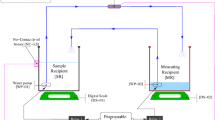Summary
The volume of the encephalic ventricles was determined from magnetic resonance imaging (MRI) scans. Since there are many conditions in which the encephalic ventricles become enlarged such as Alzheimer's disease and hydrocephalus, accurate measurement of the ventricles provides a valuable and safe means of aiding the diagnosis of such conditions and also provides important follow-up information in affected patients. The objective was pursued in a three phase study. This paper presents the data obtained from the first phase. This first phase demonstrated the possibility of measuring fluid filled spaces by MRI in three phantom preparations (small, medium, and large “ventricles”). The results were compared with those obtained from computerized tomography (CT) scans of the same preparations. These volumetric calculations were done with the aid of a Calcomp 9,000 digital analyzer programmed to compensate for the scale factor and slice thickness of the images. The phantom study showed that the results obtained from the MRI scans were better than those obtained from the CT scans in measuring the volume of water-filled cavities (ventricles) in gelatin phantoms. The average percent difference between volumes obtained by an imaging procedure compared to the actual volume as determined by water displacement was 15.8% for CT scanning and a more impressive 8.3% for MRI.
Résumé
Le volume des ventricules cérébraux a été mesuré à partir d'explorations en résonance magnétique. Il existe de nombreuses conditions pathologiques qui peuvent provoquer un élargissement ventriculaire, telles que la maladie d'Alzheimer et l'hydrocéphalie. La mesure précise de la taille des ventricules peut être d'importance pour le diagnostic de ces affections. Elle fournit également d'excellents critères de surveillance des patients porteurs de telles maladies. Notre objectif a été poursuivi au cours d'études séparées en 3 parties. Ce travail rapporte les résultats obtenus durant la première phase de cette étude. Celle-ci démontre qu'il est possible de mesurer les espaces liquidiens en IRM sur 3 fantômes ventriculaires (cavités petites, moyennes et larges). Les résultats ont été comparés avec ceux obtenus en examen tomodensitométrique des mêmes préparations. Des calculs volumétriques ont été obtenus à l'aide d'un analyseur numérique Calcomp 9 000 programmé pour corriger les facteurs d'agrandissement et les épaisseurs de coupe. L'étude des résultats des mesures de volume des cavités ventriculaires obtenus sur ces fantômes démontre que ceux-ci sont plus précis en coupes IRM qu'en coupes tomodensitométriques. La différence moyenne entre ces volumes obtenus en imagerie et les volumes réels calculés par mesure d'espaces liquidiens était de 15,8 % pour les coupes scanographiques et 8,3 % pour l'IRM.
Similar content being viewed by others
References
Brant-Zawadzki M, Kelly W, Kjos B, Newton TH, Norman D, Dillon W, Sobel D (1985) Magnetic resonance imaging and characterization of normal and abnormal intracranial cerebrospinal fluid (CSF) spaces. Neuroradiology 27: 3–8
Brinkman SD, Sarwar M, Levin HS, Morris HH (1981) Quantitative indexes of computed tomography in dementia and normal aging. Radiology 138: 89–92
Condon BR, Patterson J, Wyper D, Hadley DM, Teasdale G, Grant R, Jenkins A, Macpherson P, Rowan J (1986) A quantitative index of ventricular and extraventricular intracranial CSF volumes using MR imaging. J Comput Assist Tomogr 10: 784–792
Evans WA (1942) An encephalograhic ratio for estimating ventricular enlargement and cerebral atrophy. Arch Neurol Psychiatry 47: 931–937
Gado M, Hughes CP, Danziger W, Chi D, Jost G, Berg L (1982) Volumetric measurements of the cerebrospinal fluid spaces in demented subjects and controls. Radiology 144: 535–538
Hanigan WC, Gibson J, Kleopoulos NJ, Cusack T, Zwicky G, Wright RM (1986) Medical imaging of fetal ventriculomegaly. J Neurosurg 64: 575–580
Harvey RW (1911) The volumes of the ventricles of the brain. Anat Rec 5: 301–305
Hughes CP, Gado M (1981) Computed tomography and aging of the brain. Radiology 139: 391–396
Jernigan TL, Zatz LM, Naeser MA (1979) Semiautomated methods for quantitating CSF volume on cranial computed tomography. Radiology 132: 463–466
Lange S, Stiehl H, Von-Keyserlingk D, Habermalz E (1980) Automatic determination of cerebral ventricular volume (author's translation). Fortschr Rontgenstr 133: 18–21
Last RJ, Tompsett DH (1953) Casts of the cerebral ventricles. Br J Surg 40: 525–543
Malko J, McClees E, Braun I, Davis P, Hoffman J (1987) A nonplanimetric technique for measuring fluid volumes using MR imaging — Phantom results. AJNR 8: 267–269
Naheedy MH, Roy DH, Gilles FH (1982) Evaluation of cerebral ventricles by computed tomography in the first year of life. J Comput Assist Tomogr 6: 51–53
Novetsky GM, Berlin L (1984) Aqueductal stenosis: demonstration by MR Imaging. J Comput Assist Tomogr 8: 1170–1171
Okita N, Mochizuki H, Takase S (1985) Quantitative measurement of ventricular dilatation on CT scan: a proposal of new index and review of the literature. Neo to Shinkei (Brain and Nerve) 37: 343–347
Reid AC, Teasdale GM, Matheson MS, Teasdale EM (1981) Serial ventricular volume measurements: further insights into the aetiology and pathogenesis of benign intracranial hypertension. J Neurol Neurosurg Psychiatry 44: 636–640
Rottenberg DA, Pentlow KS, Deck MD, Allen JC (1978) Determination of ventricular volume following metrizamide CT ventriculography. Neuroradiology 16: 136–139
Sabattini L (1982) Evaluation and measurement of the normal ventricular and subarachnoid spaces by CT. Neuroradiology 23: 1–5
Thomas SR, Schneider AJ, Kereiakes JG, Lukin RR, Chambers AA, Tomsick TA (1978) An evaluation of the performance characteristics of different types of collimators used with the EMI brain scanner (MKI) and their significance in specific clinical applications. Med Phys 5: 124–132
Walser RL, Ackerman LV (1977) Determination of volume from computerized tomograms: finding the volume of fluid filled brain cavities. J Comput Assist Tomogr 1: 117–130
Author information
Authors and Affiliations
Rights and permissions
About this article
Cite this article
Cramer, G.D., Allen, D.I. & DiDio, L.J.A. Volume determinations of the encephalic ventricles with CT and MRI. Surg Radiol Anat 12, 59–64 (1990). https://doi.org/10.1007/BF02094127
Received:
Revised:
Accepted:
Issue Date:
DOI: https://doi.org/10.1007/BF02094127




